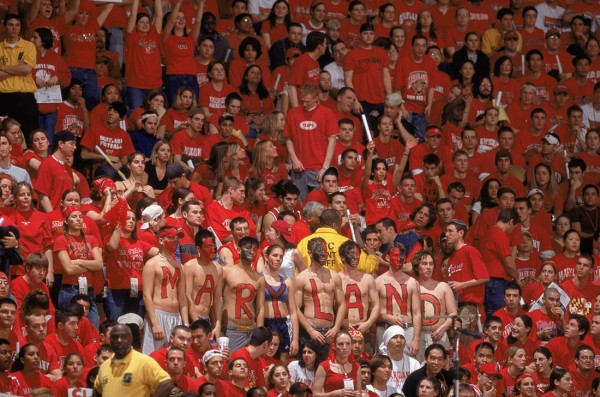Lure of Football Dollars Makes Maryland’s Historic Cole Field House Expendable
Posted by Eric Clark on November 10th, 2014Historic Cole Field House – home to Maryland basketball games from 1955 to 2002 – may in the near future undergo a transformation from sacred hoops venue to indoor football practice facility. Wallace Loh, president of the university, said that the school needs a new facility to better compete in the Big Ten and “recruit even better student-athletes.” Cole’s transformation looks to be the school’s first big expenditure in its new conference, as the move, if approved, is expected to cost approximately $160 million, according to NBC Sports.

It will take time, even with a lucrative Big Ten TV deal, for Maryland to improve its financial situation (Getty).
Perhaps the most surprising part of the renovation project is the support it’s garnered – at least $110 million of the total has already been covered by donors and boosters. This is a surprise because Cole holds a special spot in college basketball history, as the building where the Terps defeated seven No. 1 ranked teams in 47 years they called it home, notching 486 wins in the process. It was also the site of the 1966 Final Four, including the historic Brown vs. Board of Education game of all-white Kentucky versus all-black Texas Western that set into motion the desegregation of the sport. The Terrapins’ men’s and women’s basketball squads moved to the Xfinity Center in 2002, but most recently held their annual “Maryland Madness” event at Cole in 2013. Gutting the building and turning it into a football practice facility is a punch in the stomach to those who care about Maryland (and college) basketball history.
The renovation project makes some operational sense for Maryland, as it is currently the only Big Ten school without an indoor football practice facility (it’s also notable that the university is located in the warmest climate of the 14 schools). As this is Maryland’s first year in the Big Ten, it is necessary for the program to expand and spruce up its facilities in order to compete for the attention of recruits. In August 2013, The Baltimore Sun reported that costs for a new facility were estimated at $50 to $80 million dollars, which is less than half of the current approximate cost. In September 2013, Alex Prewitt of The Washington Post tweeted a series of pictures of proposed facilities, and now we’re learning of the cost more than doubling in the span of just over a year. Given the athletic department’s highly publicized financial situation, it’s odd that the school is willing to pony up so much money to tear apart a historic basketball arena and turn it into office space and a practice field.
Loh told The Washington Post in 2012 that Maryland’s move to the Big Ten was driven by “money versus tradition,” drawing criticism from all corners of the collegiate sports spectrum for his nod to fiscal realities. The school’s move from the ACC cost $31.4 million in exit fees, and the athletic department’s finances at that time were in less than stellar condition. Regardless, Maryland has made it clear that it intends to spend money in order to compete in its new conference – putting a lot of pressure on its revenue sports to compete both on the field and at the box office. Give Maryland some credit, though. The institution transparently made the move to the Big Ten in order to correct its financial woes – and the only tried-and-true way to make a lot of money is to spend a lot of money. The method to reach those goals — tearing apart a hardwood court full of history in order to recruit better football players — isn’t ideal for college basketball fans, but the lure of eight-figure bowl payouts is difficult to dismiss for a financially struggling program.










































This is nonsense. Just exactly what would you prefer they do with Cole? Leave it there just because it’s an old, historic building? This is a win-win all around. You get to turn Cole into something positive for the athletic department instead of bulldozing it and turning it into student housing or a Best Buy or whatever.